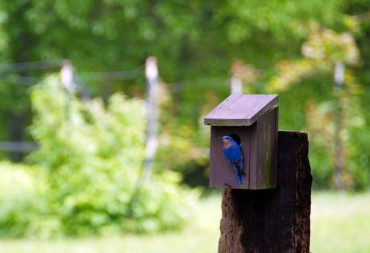 Late winter may not seem like the perfect time to think about birdhouses, but it is. As the days grow longer and temperatures moderate, our resident birds begin checking out possible nest sites.
Late winter may not seem like the perfect time to think about birdhouses, but it is. As the days grow longer and temperatures moderate, our resident birds begin checking out possible nest sites.
If your birdhouses are cleaned, repaired and in place during February, it won’t be long before you notice them being inspected by possible tenants. There are several guidelines to keep in mind when installing birdhouses.
Hole Width
Take a look at the house you plan to place somewhere in your yard. Its entrance is the most important thing to consider. The width of this opening dictates who can use the box.
The birds that are the easiest to attract to manmade houses are the black-capped and chestnut-backed chickadees, nuthatches and two swallow species, three if you hope for purple martins. Other birds will nest in houses but those mentioned here readily accept birdhouses that match certain criteria.
A house for chickadees, nuthatches and wrens should have an opening that is only 1 1/8 inches across. If it is larger, the birds will still use it but they could be preyed upon by a nonnative species, the house sparrow (formerly known as the English sparrow).
Where these sparrows aren’t a problem, an opening of 1 1/4 inches also works. With an opening this large, you may attract swallows like the violet-green or tree swallow, but another entrance design works better for these desirable, insect-eating birds.
Instead of a round entrance hole, the opening in a house for swallows should be oval-shaped. Its width should measure 3 1/2 inches across and the height from top to bottom should be exactly 7/8 inches. This entrance design allows the swallows to enter but stops the house sparrows from taking the box over or even killing young swallows after they have hatched.
Placement
Placement of a birdhouse is equally important to the entrance size. The higher the house can be placed, the better. However, birds will nest quite close to the ground when other conditions are met. Safety from predators is No. 1.
Houses mounted on poles or pipes that can’t be climbed are the best, especially if they are mounted on a structure like a carport, garage or even a large trellis. Black PVC pipe that can be slipped over the pole or metal pipe work the best.
Birds will nest in houses mounted on buildings or even hung in trees but the predator problem needs to be given serious consideration. Predators other than other birds like the house sparrows and starlings include cats, raccoons and squirrels. If the birdhouse is safe from these predators, it stands an excellent chance of being used.
Positioning
Which way the house faces is also to be considered. Face it away from the prevailing winds. Feeding parents land into the wind and don’t want it at their back.
A house faced toward the morning sun or the afternoon sun stands a better chance than one facing into the shade. This is the positioning birds seek when nesting in the wild.
A final point to consider is that nesting birds are very territorial. They won’t tolerate another bird of the same species nesting anywhere in the vicinity of their nest site. Additional birdhouses should be out of sight in another part of the yard or at the least a hundred feet away — and even that can be too close depending on the nesting bird’s territorial fervor.
Our native birds will be nesting long before we realize so the earlier the birdhouses are ready, the better.






















Comments